by Josep Del Hoyo (Editor)
An annotated, pictorial checklist of all the world’s birds.
by Josep Del Hoyo (Editor)
An annotated, pictorial checklist of all the world’s birds.
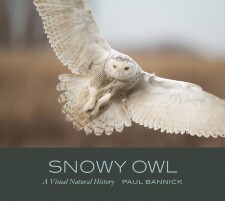 Snowy Owl: A Visual Natural History
Snowy Owl: A Visual Natural History
by Paul Bannick
From Mountaineers Books:
The Snowy Owl–also known as the Arctic Owl, Snowy White Owl, and White Owl–is one of the most easily identified but least understood owls in the world.
Award-winning author and photographer Paul Bannick delves into the natural history of this owl species, including the latest research, providing readers with comprehensive yet accessible looks at their preferred habitat, hunting and feeding behavior, mating and nesting actions, owlets and fledglings, and more.
This beautiful book follows Bannick’s bestselling titles, The Owl and the Woodpecker and Owl, providing fans with another emotionally rich photographic portfolio and engaging, informative text.
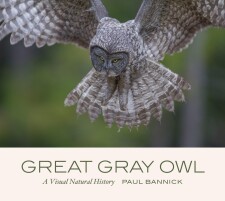 Great Gray Owl: A Visual Natural History
Great Gray Owl: A Visual Natural History
by Paul Bannick
From Mountaineers Books:
The Great Gray Owl–also known as the Phantom of the North, Great, Gray Ghost, and Bearded Owl–is one of the largest owl species and lives in the western mountains and boreal regions of North America.
Award-winning author and photographer Paul Bannick delves into the natural history of this owl species, including the latest research, providing readers with comprehensive yet accessible looks at their preferred habitat, hunting and feeding behavior, mating and nesting actions, owlets and fledglings, and more.
Bannick’s unique and gorgeous owl images are enhanced by additional images of the owls’ habitats and other species that share the Great Gray ecosystems. Throughout each narrative, his time in the field observing and photographing these enigmatic birds comes to life in evocative, experiential passages.
“A Visual Natural History”, indeed! Wow, these books are filled with some amazing photographs. But if you’ve seen either of Bannick’s previous books (Owl and The Owl and the Woodpecker), then this is no surprise. Those books prove that the author is intimately familiar with these birds, so the text here should be just as good as the pictures.
Snowy Owl: A Visual Natural History
by Paul Bannick
Hardcover; 128 pages
Mountaineers Books; October 1, 2020
ISBN: 9781680513158
18.95
Great Gray Owl: A Visual Natural History
by Paul Bannick
Hardcover; 128 pages
Mountaineers Books; October 1, 2020
ISBN: 9781680513356
18.95
October 28, 2020
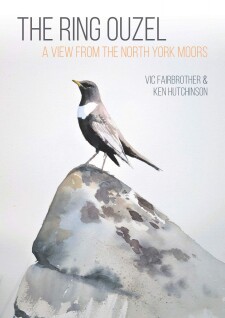 The Ring Ouzel: A View from the North York Moors
The Ring Ouzel: A View from the North York Moors
by Vic Fairbrother and Ken Hutchinson
From Whittles Publishing:
Using vivid extracts from field notebooks and profusely illustrated with photographs as well as paintings and sketches by wildlife artist Jonathan Pomroy, the reader is transported to the beautiful North York Moors National Park. We can share in the excitement as the first Ring Ouzels of the year return from their winter quarters in North Africa, witness their courtship displays, the establishment of territories and the female ouzel painstakingly building her nest and laying her eggs.
To hear the song of the Ring Ouzel carrying for a surprising distance across the high moorland in the early morning is one of the many delights of upland Britain. The authors have recorded and analysed both simple and complex songs in their study area and, following comparison with recordings from Scotland, Derbyshire and the Yorkshire Dales, have confirmed the suspected presence of local dialects.
Crucially this book is much more than a remarkable record of twenty years’ fieldwork as it builds on earlier research elsewhere and relates local findings to the results of other current studies in England, Wales and Scotland. As a migrant, the Ring Ouzel faces additional pressures and problems on passage and conditions in their wintering areas in the Atlas Mountains of Morocco are described. The importance of Britain as a stop-over and refuelling area for Fennoscandian birds on passage in Spring and Autumn is stressed. This milestone publication bring the Ring Ouzel into sharp focus for the first time.
I’ve never seen a Ring Ouzel, but I could really get to know them through this book. Lots of photos, along with some beautiful paintings, accompany years’ worth of observations and data. Anyone remotely interested in this cool-looking thrush or this area of Britain should enjoy this.
The Ring Ouzel: A View from the North York Moors
by Vic Fairbrother and Ken Hutchinson
Paperback; 288 pages
Whittles Publishing; September, 2020
ISBN: 9781849954587
$27.95
Buy from NHBS
(based in the U.K.)
October 21, 2020
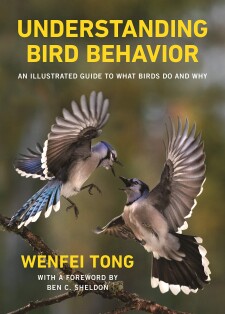 Understanding Bird Behavior: An Illustrated Guide to What Birds Do and Why
Understanding Bird Behavior: An Illustrated Guide to What Birds Do and Why
by Wenfei Tong
From Princeton University Press:
Birds are intelligent, sociable creatures that exhibit a wide array of behaviors―from mobbing and mimicking to mating and joint nesting. Why do they behave as they do? Bringing to light the remarkable actions of birds through examples from species around the world, Understanding Bird Behavior presents engaging vignettes about the private lives of birds, all explained in an evolutionary context.
We discover how birds find food, relying on foraging techniques, tools, and thievery. We learn about the courtship rituals through which birds choose, compete for, woo, and win mates; the familial conflicts that crop up among parents, offspring, and siblings; and the stresses and strains of nesting, including territory defense, nepotism, and relationship sabotage. We see how birds respond to threats and danger―through such unique practices as murmurations, specific alarm calls, distraction displays, and antipredator nest design. We also read about how birds change certain behaviors―preening, migration, breeding, and huddling―based on climate. Richly illustrated, this book explores the increasing focus on how individual birds differ in personality and how big data and citizen scientists are helping to add to what we know about them.
Drawing on classic examples and the latest research, Understanding Bird Behavior offers a close-up look at the many ways birds conduct themselves in the wild.
- Compelling insights into bird behavior
- Classic examples and the latest research, including work by citizen scientists
- Fascinating vignettes about the private lives of birds, from finding food and family life, to coping with climate and other threats
- 150 detailed color illustrations and photographs
Short, two-page sections cover a variety of topics related to bird behavior. This arrangement makes it easy to pick up the book and quickly learn about a topic of interest. I also like how it includes examples from around the world. However, it does not have the breadth or depth of the also recently published Peterson Reference Guide to Bird Behavior.
Note: this is published as How to Read a Bird: A Smart Guide to What Birds Do and Why in England by The History Press.
Understanding Bird Behavior: An Illustrated Guide to What Birds Do and Why
by Wenfei Tong
Hardcover; 224 pages
Princeton University Press; September 22, 2020
ISBN: 9780691206004
$27.95
October 6, 2020
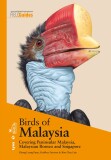
by Chong Leong Puan, Geoffrey Davison, and Kim Chye Lim
The most up-to-date and user friendly field guide to this region.
September 2, 2020
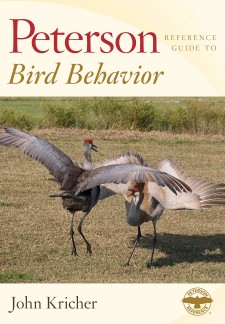 Peterson Reference Guide to Bird Behavior
Peterson Reference Guide to Bird Behavior
by John Kricher
From Houghton Mifflin Harcourt:
A fascinating look at what birds do and why they do it
Both casual and serious birdwatchers can take their skills to the next level with this detailed consideration of bird behavior. This book makes it possible to move beyond identifying birds to understanding some of the underpinning and meaning to what birds do, how they do it, and why they do it. Written in an easy-to-understand style, with an abundance of photos illustrating the behaviors, the book shows how flight, molt, migration, feeding, predation, social behavior, courtship, and nesting shape birds’ behaviors. Birds are everywhere, and easy to observe; this introduction to elements of bird behavior will connect readers more intimately with these remarkable and beguilingly perceptive animals.
Another fabulous entry in the Peterson Reference Guide series. This year will see more than a few books published on bird behavior, but I would be surprised if any will be an better overall introduction to this topic.
Peterson Reference Guide to Bird Behavior
by John Kricher
Hardcover; 360 pages
Houghton Mifflin Harcourt; September 1, 2020
ISBN: 9781328787361
$35.00
August 5, 2020
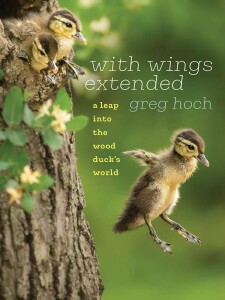 With Wings Extended: A Leap into the Wood Duck’s World
With Wings Extended: A Leap into the Wood Duck’s World
by Greg Hoch
From University Of Iowa Press:
A century ago, many people had given up on the wood duck, dooming it to extinction along with the passenger pigeon and Carolina parakeet. Today, it’s one of the most familiar and most harvested ducks in the eastern half of the country, and one of America’s great conservation success stories.
In With Wings Extended, Minnesota conservationist Greg Hoch introduces readers to a duck they probably recognize but may not know well. This book shows how almost anyone can get involved in conservation and do something for wildlife beyond writing checks to conservation organizations. Hoch illustrates the complexities of wildlife and habitat management that landowners as well as state and federal wildlife agencies deal with on a daily basis, and takes readers through the life stages of what is largely considered the most beautiful duck in the world. In this fascinating and practical read, Hoch blends the historical literature about the species with modern science, and also shows how our views of conservation have changed over the last century.
This is Greg Hoch’s third book in this series, following accounts of Greater Prairie-Chicken and American Woodcock. I reviewed the latter – Sky Dance of the Woodcock – and found it to be a very enjoyable, accessible account. This looks to be the same – except this new one is graced with some color photographs. If you have any interest in Wood Ducks or habitat management, then you should check it out.
With Wings Extended: A Leap into the Wood Duck’s World
by Greg Hoch
Paperback; 184 pages
University Of Iowa Press; May 4, 2020
ISBN: 9781609386955
$35.00
July 27, 2020
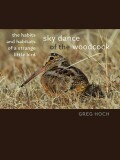
by Greg Hoch
A look into the world of the American Woodcock, one of the strangest birds around.
by Gombobaatar Sundev and Christopher Leahy
The first comprehensive field guide to the birds to Mongolia.
May 11, 2020
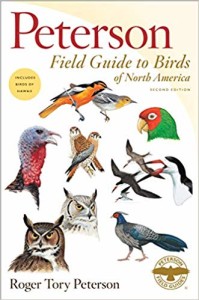
I love going through new fields guides to see what has changed: new species added, maybe some new illustrations, more features. So I’ve spent a little time going though the new Peterson Field Guide to Birds of North America, Second Edition page-by-page, comparing it against the previous edition (which was, surprisingly, published about 12 years ago). The changes I’ve found are detailed below. I am not, however, including illustrations and range maps that have been tweaked. I noticed many such instances, especially changes to the colors of existing illustrations. And I’m sure that I missed many more.
The big, shiny new feature in this second edition is the inclusion of the Birds of Hawaii! This is a separate, 50-page section following the main plates. The organization is the same as in the main body, with illustrations on the right and text accounts/range maps on the left. The maps are particularly nice, showing both the range against the entire island chain along with zoomed-in depictions of each island.
Forward and Editor’s Note
Large range maps in the back
You would expect this new edition to be larger than the first, especially with the adding of Hawaii. But in fact, these removals more than offset the additions so that this edition is 24 pages shorter and 15% (6oz) lighter.
Introduction – largely the same, but with a few minor changes, such as the inclusion of some examples from Hawaii.
Terminology – this edition has “refined and standardized our terminology, replacing such imprecise terms as ‘immature’ with specific age groupings (such as juvenile, adult, first-year, second-winter, etc.) and, for plumages, we have replace the labels ‘breeding’ and ‘nonbreeding’ with ‘spring/summer’ and ‘fall/winter,’ respectively”. Further, the male and female symbols have been replaced with the word.
Sequence – although there is no mention of it in the introduction, the sequence of birds has been changed from strictly taxonomic to one that groups “waterbirds” together first, then “landbirds”, very similar to the order used by The Crossley ID Guide
Range maps – now includes migration range in yellow
Plates (Species in bold are new to this edition.)
Here are the few errors that I noticed.